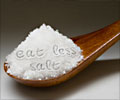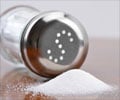Researchers have found out how animals used their tongue to detect high concentrations of salt, which is the first step in the development of salt-avoiding behavior in most mammals.

The findings could serve as a springboard for the development of taste modulators to help control the appetite for a high-salt diet and reduce the ill effects of too much sodium. The findings were published today online in Nature.
The sensation of saltiness is unique among the five basic tastes. Whereas mammals are always attracted to the tastes of sweet and umami, and repelled by sour and bitter, their behavioral response to salt dramatically changes with concentration.
"Salt taste in mammals can trigger two opposing behaviors," said Dr. Charles Zuker, professor in the Departments of Biochemistry & Molecular Biophysics and of Neuroscience at Columbia University College of Physicians & Surgeons. "Mammals are attracted to low concentrations of salt; they will choose a salty solution over a salt-free one. But they will reject highly concentrated salt solutions, even when salt-deprived."
Over the past 15 years, the receptors and other cells on the tongue responsible for detecting sweet, sour, bitter, and umami tastes—as well as low concentrations of salt—have been uncovered largely through the efforts of Dr. Zuker and his collaborator Nicholas Ryba from the National Institute of Dental and Craniofacial Research.
"But we didn't understand what was behind the aversion to high concentrations of salt," said Yuki Oka, a postdoctoral fellow in Dr. Zuker's laboratory and the lead author of the study.
Advertisement
In experiments conducted by Dr. Oka, the researchers found that high salt concentrations activate previously discovered bitter- and sour-sensing cells. When one of these cell types was silenced and made incapable of sending messages to the brain, aversion to high-salt solutions was reduced, but not eliminated. When both cell types were silenced, the mammals completely lost their aversion to high-salt solutions, even showing unrestrained attraction to exceedingly salty solutions equivalent to those of seawater.
Advertisement
Now that all the salt pathways have been identified, Dr. Oka said, it may be possible to use that knowledge to make low concentrations of salt taste saltier, to reduce NaCl intake. It also may be possible to make the taste of KCl (potassium chloride), which has fewer long-term health effects than sodium chloride, more appealing to encourage its use as a salt substitute.
Taste Cells Will Lead to Understanding Where Sensations Are in the Brain
Though the commercial implications of the work are clear, the researchers' objective is not to find ways to alter our tastes, but to understand how we perceive the sensory world. How does the detection of high salt oncentrations on the tongue lead to a decision to turn away from a source of water? How can we tell the difference between chocolate cake and pumpkin pie? How do our taste sensations change over time? The answers are in the firing of neurons in the brain.
With the taste receptor cells in hand, the researchers have recently turned to brain imaging, mapping the neurons that receive information from the tongue's taste buds. The map was a surprise. Instead of finding the neurons scattered, as the taste receptor cells on the tongue are, they found discrete hotspots of the brain for each of four tastes: sweet, bitter, umami, and salty (sour has not yet been located).
Ultimately, they hope to understand how the firing of these neurons produces the sensations we call tastes.
Source-Eurekalert











